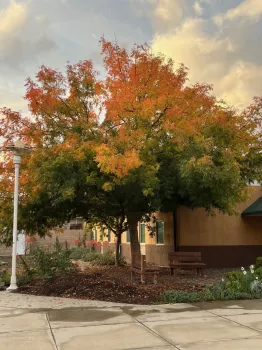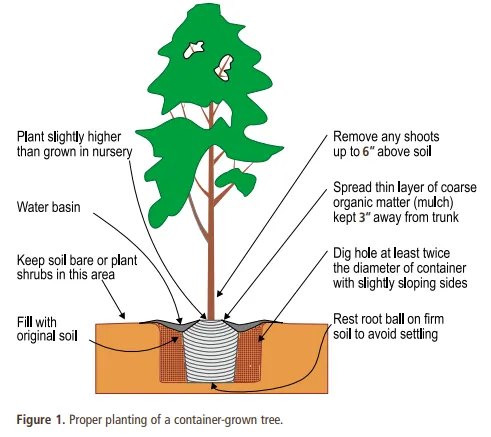
Want fall color in your landscape next year?
Read about the trees you've noticed around town that are currently “popping” with color. And, if you plant a tree now (or in early spring), you can have fall color in your landscape next year! Here are some excellent tree species to choose from that thrive in our area (USDA Zone 9b):
Chinese Pistache – Pistachia chinensis
The Chinese pistache is Ed Perry's favorite tree. Ed was the Environmental Horticulture Advisor for over 35 years at UC Cooperative Extension in Stanislaus County. He chose this tree not only for its fall color, but because it produces good shade and has “well-behaved” roots. Opt for the male cultivar ‘Keith Davey.' Female cultivars have colorful berries which although pretty, are considered messy and not suitable for over a patio.
Height: 30-50'
Light needs: Plant in full sun.
Water needs: Moderate. Does well in lawns.
Note: You can't go wrong with this tree! Also, it is not closely related to the nut bearing pistachio tree.
Maple Trees – Acer rubrum

Light needs: Plant in full sun or partial shade.
Height: 40-50'
Water needs: Regular water. Does well in lawns, but water separately from the lawn.
Note: Sprinkler water will not be enough for this tree.
Bradford Flowering Pear – Prunus calleryana ‘Bradford'
This flowering pear has cheerful white blooms in spring and produce fall color during cool winters. Their roots are well-behaved so they can be planted near sidewalk. Please note, many cultivars of flowering pear have problems such as mistletoe and fireblight. Make sure you choose a Bradford pear. After bloom, this tree does drop small fruits that are messy.
Height: 40-50'
Light needs: Plant in full sun.
Water needs: Moderate. Does well in lawns.
Note: although bred to be fruitless, the Bradford pear cross pollinates with other pears which is why it produces inedible “fruit.”
Japanese Maple Trees – Acer palmatum

Light needs: Plant in partial shade, some species (‘Emperor One') are adapted to full sun.
Height: 6-20', varies. Do some research before choosing your tree.
Water needs: Regular water.
Note: This tree can give year-round interest!
Ginkgo – Ginkgo biloba
This ancient tree existed long before dinosaurs roamed the earth. In fact, fossils of gingko leaves have been discovered from the Jurassic period! Ginkgo trees leaves turn a beautiful golden color in fall. Choose a male cultivar such as ‘Saratoga' or ‘Autumn Gold.' Female cultivars produce fruit that some people consider unpleasant.
Light needs: Plant in full sun.
Height: 30-50.'
Water needs: Moderate water; can tolerate drought but won't look healthy.
Note: Excellent street or patio tree, also does well in a lawn.
Liquidambar – Liquidambar styraciflua

Light needs: Plant in full sun.
Height: 50-60.'
Water needs: Regular water.
Note: Surface roots can crack sidewalks and come up in lawns.
Tree Notes – Choosing a Tree
When choosing a tree, look for one with leaves growing along the entire stem. Avoid trees that resemble a mature tree (with a long stem and a heavy top). The leaves are necessary to help the tree develop a strong trunk.
Tree Notes – Planting
Planting a tree correctly is essential to having a healthy tree. Follow these steps:
Step 1: Remove the tree stake.
Step 2: Dig a hole twice as wide but the same depth as the container.
Step 3: After removing the “root ball” (area of soil and roots) from the container, set it in the hole.
Step 4: Make sure the top of the root ball is lined up with the surrounding soil or a little higher.
Step 5: Fill in around the root ball with removed soil, do not cover over the root ball with soil. Make sure the root ball is still showing and is level with the ground.
Step 6: Create a basin around the base of the tree and water well.

Tree Notes – Staking
If you remove the stake from your new tree and it falls over, return the tree. Healthy trees should not fall over and do not need to be staked. In fact, a tree that can't stand upright that grows into a mature tree is likely to become a landscape hazard** in the future.
Allowing your new tree to sway with the wind helps it develop a strong trunk and root system. The only time it is recommended to stake trees is in areas with heavy wind. In this case, two stakes should be used, and then removed after one year. Learn more about tree staking in the Planting Landscape Trees publication below.
Tree Notes – Water
All newly planted trees need regular water for the first 2-5 years after planting. Regular water means keeping the soil moist but not too wet or allowing it to dry out. Once their roots are established, trees need deep water once or twice per month during the dry season (May-October), depending on temperature, tree species, soil type, and other factors.
Resources
Stanislaus County Tree Guide
Looking for more tree recommendations? Visit our publications page and scroll to the bottom of the page to click on our “Trees in Your Home Garden” publication at https://cestanislaus.ucanr.edu/Gardening_Publications/
Planting Landscape Trees
https://anrcatalog.ucanr.edu/pdf/8046.pdf
*University research has shown that adding amendments such as compost and fertilizer to planting holes does not help trees; in fact, it can cause problem. Read more at https://ucanr.edu/blogs/blogcore/postdetail.cfm?postnum=46215
**worried you may have a hazardous tree in your landscape? Download this free guide for tips on how to inspect it. https://anrcatalog.ucanr.edu/pdf/8365.pdf

